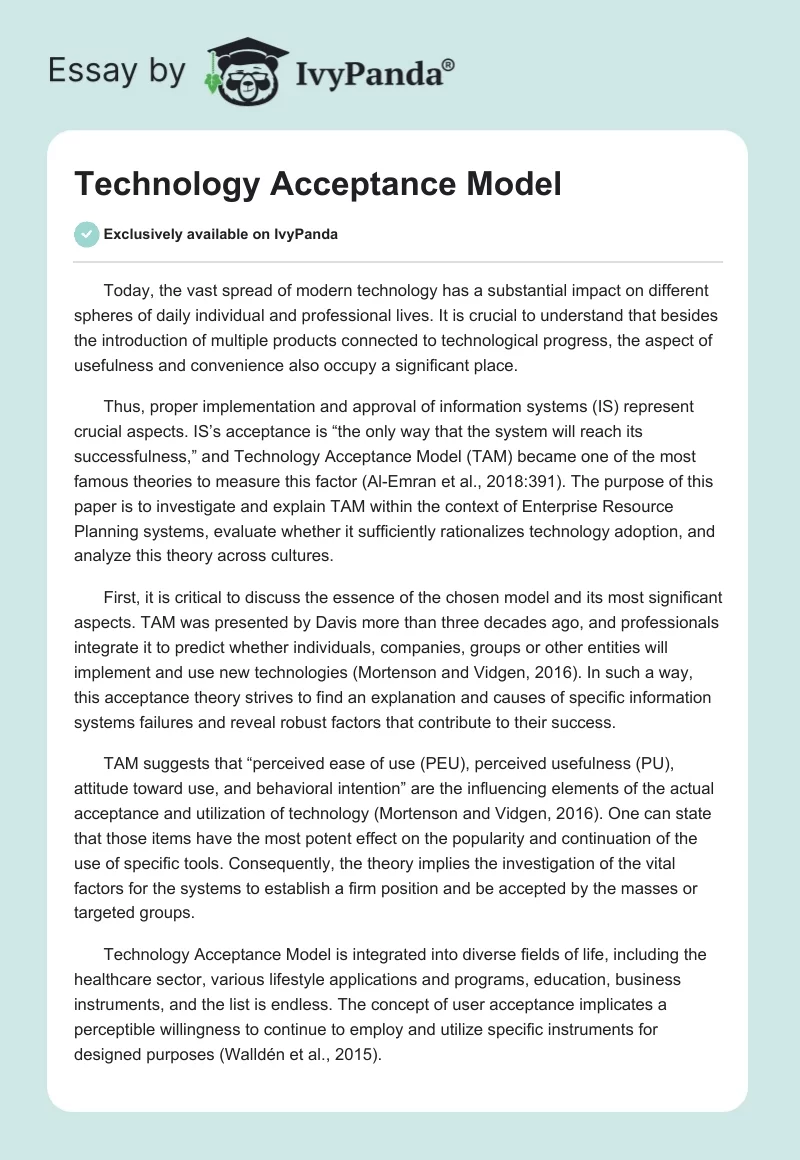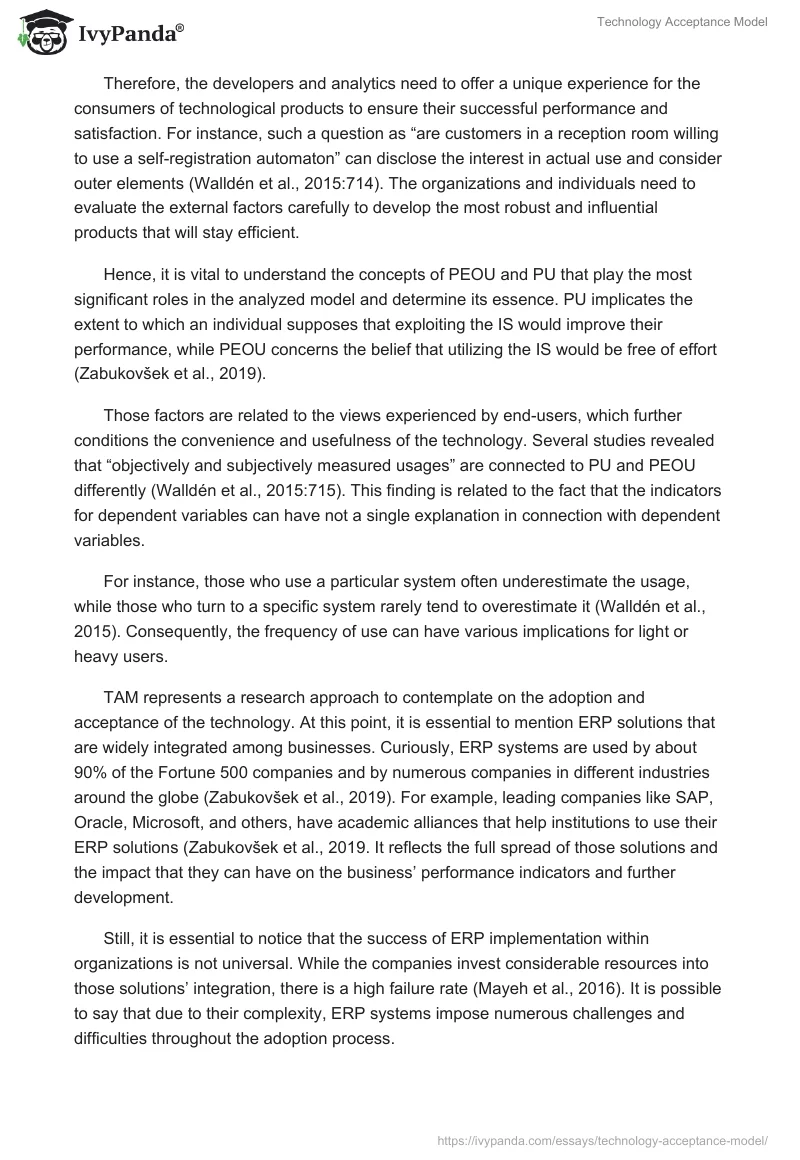Today, the vast spread of modern technology has a substantial impact on different spheres of daily individual and professional lives. It is crucial to understand that besides the introduction of multiple products connected to technological progress, the aspect of usefulness and convenience also occupy a significant place.
Thus, proper implementation and approval of information systems (IS) represent crucial aspects. IS’s acceptance is “the only way that the system will reach its successfulness,” and Technology Acceptance Model (TAM) became one of the most famous theories to measure this factor (Al-Emran et al., 2018:391). The purpose of this paper is to investigate and explain TAM within the context of Enterprise Resource Planning systems, evaluate whether it sufficiently rationalizes technology adoption, and analyze this theory across cultures.
First, it is critical to discuss the essence of the chosen model and its most significant aspects. TAM was presented by Davis more than three decades ago, and professionals integrate it to predict whether individuals, companies, groups or other entities will implement and use new technologies (Mortenson and Vidgen, 2016). In such a way, this acceptance theory strives to find an explanation and causes of specific information systems failures and reveal robust factors that contribute to their success.
TAM suggests that “perceived ease of use (PEU), perceived usefulness (PU), attitude toward use, and behavioral intention” are the influencing elements of the actual acceptance and utilization of technology (Mortenson and Vidgen, 2016). One can state that those items have the most potent effect on the popularity and continuation of the use of specific tools. Consequently, the theory implies the investigation of the vital factors for the systems to establish a firm position and be accepted by the masses or targeted groups.
Technology Acceptance Model is integrated into diverse fields of life, including the healthcare sector, various lifestyle applications and programs, education, business instruments, and the list is endless. The concept of user acceptance implicates a perceptible willingness to continue to employ and utilize specific instruments for designed purposes (Walldén et al., 2015).
Therefore, the developers and analytics need to offer a unique experience for the consumers of technological products to ensure their successful performance and satisfaction. For instance, such a question as “are customers in a reception room willing to use a self-registration automaton” can disclose the interest in actual use and consider outer elements (Walldén et al., 2015:714). The organizations and individuals need to evaluate the external factors carefully to develop the most robust and influential products that will stay efficient.
Hence, it is vital to understand the concepts of PEOU and PU that play the most significant roles in the analyzed model and determine its essence. PU implicates the extent to which an individual supposes that exploiting the IS would improve their performance, while PEOU concerns the belief that utilizing the IS would be free of effort (Zabukovšek et al., 2019).
Those factors are related to the views experienced by end-users, which further conditions the convenience and usefulness of the technology. Several studies revealed that “objectively and subjectively measured usages” are connected to PU and PEOU differently (Walldén et al., 2015:715). This finding is related to the fact that the indicators for dependent variables can have not a single explanation in connection with dependent variables.
For instance, those who use a particular system often underestimate the usage, while those who turn to a specific system rarely tend to overestimate it (Walldén et al., 2015). Consequently, the frequency of use can have various implications for light or heavy users.
TAM represents a research approach to contemplate on the adoption and acceptance of the technology. At this point, it is essential to mention ERP solutions that are widely integrated among businesses. Curiously, ERP systems are used by about 90% of the Fortune 500 companies and by numerous companies in different industries around the globe (Zabukovšek et al., 2019). For example, leading companies like SAP, Oracle, Microsoft, and others, have academic alliances that help institutions to use their ERP solutions (Zabukovšek et al., 2019. It reflects the full spread of those solutions and the impact that they can have on the business’ performance indicators and further development.
Still, it is essential to notice that the success of ERP implementation within organizations is not universal. While the companies invest considerable resources into those solutions’ integration, there is a high failure rate (Mayeh et al., 2016). It is possible to say that due to their complexity, ERP systems impose numerous challenges and difficulties throughout the adoption process.
Still, more than 60% of the US companies are at different stages of integrating ERP solutions, which is an example of continuous attempts to adopt technologies (Mayeh et al., 2016). Consequently, it is vital to assess software, programs, and applications to derive positive outcomes and incorporate them properly.
Various theories and approaches are used to determine and analyze the elements affecting the acceptance of information systems. Such models as the theory of reasoned action, innovation diffusion theory, stage model, the theory of planned behavior, and others, exist along with TAM (Zabukovšek et al., 2019). Accordingly, businesses can utilize multiple methods to evaluate the adoption of specific technology and decide whether it is practical to move with it.
One of the factors that establish TAM’s popularity is that it is considered to be “more parsimonious, predicative, and robust” in comparison to other approaches (Zabukovšek et al., 2019:52). It implies that the researchers tend to prefer the integration of this theory to make the process cost-effective and produce the most detailed and valuable results.
Nevertheless, one should state that numerous models, and the fact that TAM can generate the most efficient results does not indicate that the theory provides the full explanation for technology adoption. Although TAM can be applied to multiple technologies, including various ERP solutions, it still requires modifications or extensions for the analysis of specific IS (Zabukovšek et al., 2019).
Therefore, other external factors can be added to the classic technology acceptance model to create a complete picture for a particular technology. The elements that can be included in the analysis of specific IS can be divided into three major groups. Those groups involve personal characteristics and information literacy, organizational-process features, and system and technological descriptions ((Zabukovšek et al., 2019). The analysis of a particular ERP solution implicates that those characteristics can be distinctive and offer more insights for the system.
The next point is the system usage, which is directly related to the TAM elements and helps to investigate the level of acceptance and adoption. System usage can be defined as “user’s employment of one or more features of a system to perform a task” (Walldén et al., 2015:715). Hence, individuals’ ability to utilize a specific ERP solution or other technology to increase productivity and improve the outcomes impacts the satisfaction and approval of the system.
Another crucial aspect in the analysis of technology acceptance and adoption is the influence of cultural differences. Diverse cultural values and beliefs impact users’ “innovative behaviors of accepting technology-related products” (Muk and Chung, 2015:1). Consequently, the level of the usage of integrated information solutions can vary from culture to culture and can depend on individuals’ preferences based on that.
One of the studies conducted by Muk and Chung analyzed the differences in attitudes and relations to use between American and Korean communities. The findings revealed that for Korean users, PU becomes the dominant factor, while for Americans, social influence also plays a significant role (Muk and Chung, 2015). This example illustrates the weight that culture can have on technological integration and the perception of it.
It is also curious to investigate the extent of technology-adoption in Saudi Arabia that has distinct cultural characteristics. One research suggests that power distance and individualism have a substantial effect on resistance and involvements with ERP, while uncertainty avoidance significantly impacts those elements (Alhirz and Sajeev, 2015).
Besides the factors included in TAM, the evaluation needs extensions that can serve as moderators. In such a way, educational level, knowledge about ERP, and the size or organizations can also have the power to shape technology perception and use (Alhirz and Sajeev, 2015). As a result, one can state that particular aspects that are characteristic of the culture, values, and traditions, can affect the acceptance of IS and, therefore, have different implications for the businesses.
In conclusion, TAM represents a robust theory to investigate the acceptance and adoption of various technology. The model has proved to be parsimonious and descriptive and, along with other approaches, became a useful tool for businesses and organizations. Despite the widespread of this theory, it can be modified and extended depending on the specifics of particular information systems. The popularity of ERP solutions among organizations highlights the significance of TAM integration, aiming to analyze the level of technology adoption. Moreover, cultural values play a critical role in the level of IS’s acceptance among communities.
Reference List
Al-Emran, M., Mezhuyev, V. and Kamaludin, A. (2018) ‘Technology Acceptance Model in M-learning context: a systematic review.’ Computers & Education, 125 pp. 389-412.
Alhirz, H. and Sajeev, A.S.M. (2015) ‘Do cultural dimensions differentiate ERP acceptance? A study in the context of Saudi Arabia.’ Information Technology & People, 28(1) pp. 163-194.
Mayeh, M., Ramayah, T. and Mishra, A. (2016) ‘The role of absorptive capacity, communication and trust in ERP adoption.’ Journal of Systems and Software, 119 pp. 58-69.
Mortenson, M.J. and Vidgen, R. (2016) ‘A computational literature review of the technology acceptance model.’ International Journal of Information Management, 36(6) pp. 1248-1259.
Muk, A. and Chung, C. (2015) ‘Applying the technology acceptance model in a two-country study of SMS advertising.’ Journal of Business Research, 68(1) pp. 1-6.
Walldén, S., Mäkinen, E. and Raisamo, R. (2015) ‘A review on objective measurement of usage in technology acceptance studies.’ Universal Access in the Information Society, 15(4) pp. 713-726.
Sternad Zabukovšek, S., Picek, R., Bobek, S., Šišovska Klančnik, I. and Tominc, P. (2019) ‘Technology Acceptance Model based study of students’ attitudes toward use of Enterprise Resource Planning solutions.’ Journal of Information and Organizational Sciences, 43(1) pp. 49-71.


